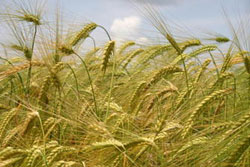



Breeding Better Barley for Feed
DENMARK - Scientists from the Faculty of Agriculture at the University of Aarhus are searching to improve the protein composition of barley. The scientists are working on finding barley with an optimal protein composition that not only satisfies animal protein requirements but is also environmentally friendly.
The scientists are looking for a new kind of barley which has the 'right kind' of protein content and amino acid composition.
They believe that better quality barley could:
- Save money for farmers (because they can decrease the amount of supplements in the feed)
- Decrease the need for importing protein
- Help reduce the amount of unutilised nitrogen ending up in the environment
Up until now, feed barley has been bred to meet the requirements for farm animals, with a high protein content, the nutritional value has not been addressed. The traditional feed barley has negative environmental impacts. The higher quantities of protein also hold non essential amino acids such as proline and glutamine, these are often unused by the animal and pass through the digestive system ending up as nitrogen contamination in the manure. The manure is then typically spread acrosss land, and the excess nitrogen leaches through soil into water courses.
One option would be to feed with low-protein barley, however additional protein supplements would then be needed in the feed.
Senior scientist, Eva Vincze from the Faculty of Agricultural Sciences believes money could be saved if they could find barley cultivars with a high protein content but a lower content of proline and glutamine.
Eva Vincze and her colleagues have started the search for this breed of barley, having collected over 300 different barley cultivars from all over the world and through using modern genetic technology, they hope to find the characteristics of all high protein cultivars.
"We are already familiar with the gene expression profiles coding for storage proteins during grain development. We found that the different members of these protein ”families” are different in amino acid composition and expression at different times during grain development. We want to promote the right families (alleles with a better protein composition)," explains Eva Vincze. Once good cultivars are found, the next step will be to breed for the trait.
The project which began in January 2008, is financed by the Danish Ministry of Food, and is being carried out with the help of Sejet Plan Breeding, Danish Pig Production and local farmers, who will perform feed trials with the potentially 'good' cultivars.
Further Reading
| - | For more information clicking here. |









